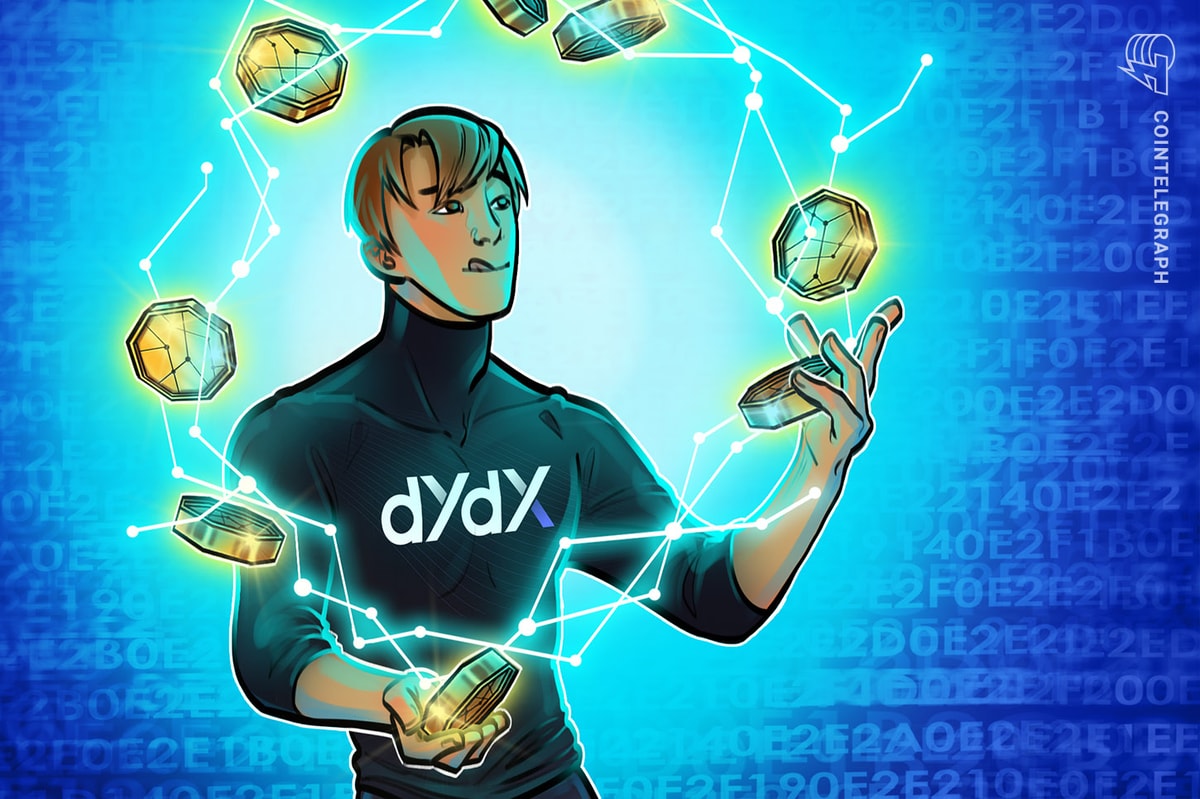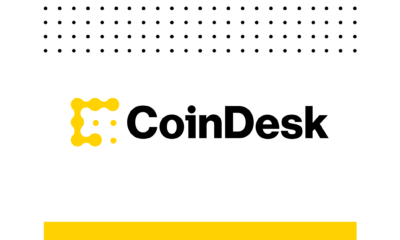Uncategorized
DYDX shoots up 10% as buybacks get a quarter of protocol revenue
Published
1 month agoon
By
admin
Decentralized finance (DeFi) trading platform dYdX announced its first-ever token buyback program on March 24, aiming to reinvest in its ecosystem to enhance security and governance.
According to the announcement, 25% of the protocol’s net fees will be dedicated to monthly buybacks of its native dYdY (DYDX) token on the open market.
Following the announcement, DYDX surged over 10% and was trading at approximately $0.731 at the time of writing, according to CoinGecko. The token has gained more than 21% over the past two weeks.
DYDX spikes on buyback news. Source: CoinGecko
Related: dYdX explores sale of derivatives trading arm
New dYdX distribution model
Previously, dYdX distributed 100% of its platform revenue to ecosystem participants. Under the new allocation model, 25% will be used for token buybacks, another 25% will fund its USDC liquidity provision program, MegaVault, 10% will be directed to its treasury, and the remaining 40% will continue as staking rewards.
dYdX noted that the current allocation of 25% to token buybacks could increase, with ongoing community discussions potentially pushing this percentage to as high as 100% over time.
Related: DeFi market stages a comeback as derivatives surge
The platform currently holds a total value locked (TVL) of $279 million, according to DefiLlama. It generated $1.29 million in revenue from fees in February and $1.09 million so far in March.
Token buybacks get 25% of revenue, which has been dropping. Source: DefiLlama
“DeFi festival” waits for summer to end
The DeFi industry commonly references the DeFi summer of 2020 as a benchmark, characterized by rapid user growth driven by yield farming and decentralized applications.
In a recent interview with Cointelegraph, dYdX Foundation CEO Charles d’Haussy predicted that the next significant DeFi boom would occur shortly after summer, potentially beginning as early as September and lasting “months and months.”
dYdX existed in mid-2020 primarily as a DeFi platform for spot trading, lending, borrowing, and margin trading. Its popularity popped in 2021 following the launch of its layer-2 perpetual futures exchange and the introduction of its native DYDX token. In its 2024 ecosystem report, dYdX projected that the decentralized derivatives market would expand to $3.48 trillion by 2025, up from $1.5 trillion in derivatives volume processed by decentralized exchanges (DEXs) in 2024. Magazine: Memecoins are ded — But Solana ‘100x better’ despite revenue plunge Ethereum community members propose new fee structure for the app layer Crypto Investors Sue Nike, Accuse Apparel Giant of Rug Pull After Abrupt Closure of Metaverse Business: Report Top cryptocurrencies to watch: Pi Network, XRP, Sui This Week in Crypto Games: Ubisoft’s ‘Might & Magic’, ‘Peaky Blinders’ in Development Why Arbitrum-Nvidia Partnership Collapsed – And What It Means for Web3 Tariff Carnage Starting to Fulfill BTC’s ‘Store of Value’ Promise Published on By Two Ethereum community members, Kevin Owocki and Devansh Mehta, proposed a dynamic fee structure for the Ethereum application layer to strike a balance between revenue generation for app builders and fairness in fee extraction. The April 27 proposal outlined a simple equation that uses a square root function that proportionally lowers the percentage of fees as the funding capital allocated to a particular project grows. Owocki and Mehta explained: “For smaller funding amounts, the fee follows a square root function (sqrt(1000 x N)), providing proportionally higher returns to make building mechanisms for smaller pools worthwhile. For example, if the funding pool is $170,000, then the root of 1000 x 170,000 equals $13,038.4 or 7% is taken as overhead.” The authors of the proposal added that fees would be capped at 1% once a particular application’s funding pool crossed the $10 million level, ensuring that small app builders can develop decentralized applications without excess fees while also encouraging project and funding growth by capping fees as developers scale their applications. Owocki and Mehta’s proposal to balance revenue generation and profitability among Ethereum’s app builders reflects the growing calls to reform fee structures and value accrual mechanisms to maintain Ethereum’s economic viability against competing networks. Related: Ethereum’s L2 approach equals many high-throughput chains — Avail exec In 2024, the Solana ecosystem onboarded more developers than the Ethereum network, attracting 7,625 new developers compared with Ethereum’s 6,456. Despite the surge in software developers building on the Solana network in 2024, Ethereum remains the dominant ecosystem for attracting developer talent, although the 2024 data shows that position is no longer uncontested. According to onchain analytics firm Santiment, Ethereum fees dropped to five-year lows in April 2025 due to low activity on the Ethereum base layer resulting from reduced demand for smart contract operations like decentralized finance. This reduced demand is leading to many institutions scaling back their Ether (ETH) holdings or selling off portions of their investment as investor sentiment toward the first-ever smart-contract platform continues to erode without any clear catalysts for a reversal. Magazine: Ethereum is destroying the competition in the $16.1T TradFi tokenization race Published on By Opinion by: Hedi Navazan, chief compliance officer at 1inch Web3 needs a clear regulatory system that addresses innovation bottlenecks and user safety in decentralized finance (DeFi). A one-size-fits-all approach cannot be achieved to regulate DeFi. The industry needs custom, risk-based approaches that balance innovation, security and compliance. A common critique is that regulatory scrutiny leads to the death of innovation, tracing this situation back to the Biden administration. In 2022, uncertainty for crypto businesses increased following lawsuits against Coinbase, Binance and OpenSea for alleged violations of securities laws. Under the US administration, the Securities and Exchange Commission agreed to dismiss the lawsuit against Coinbase, as the agency reversed the crypto stance, hinting at a path toward regulation with clear boundaries. Many would argue that the same risk is the same rule. Imposing traditional finance requirements on DeFi simply will not work from many aspects but the most technical challenges. Openness, transparency, immutability, and automation are key parameters of DeFi. Without clear regulations, however, the prevalent issue of “Ponzi-like schemes” can divert focus from effective innovation use cases to conjuring a “deceptive perception” of blockchain technology. Guidance and clarity from regulatory bodies can reduce significant risks for retail users. Policymakers should take time to understand DeFi’s architecture before introducing restrictive measures. DeFi needs risk-based regulatory models that understand its architecture and address illicit activity and consumer protection. The entire industry highly recommends implementing a self-regulatory framework that ensures continuous innovation while simultaneously ensuring consumer safety and financial transparency. Take the example of DeFi platforms that have taken a self-regulatory approach by implementing robust security measures, including transaction monitoring, wallet screening and implementing a blacklist mechanism that restricts a wallet of suspicion with illicit activity. Sound security measures would help DeFi projects monitor onchain activity and prevent system misuse. Self-regulation can help DeFi projects operate with greater legitimacy, yet it may not be the only solution. It’s no secret that institutional players are waiting for the regulatory green light. Adding to the list of regulatory frameworks, Markets in Crypto-Assets (MiCA) sets stepping stones for future DeFi regulations that can lead to institutional adoption of DeFi. It provides businesses with regulatory clarity and a framework to operate. Many crypto projects will struggle and die as a result of higher compliance costs associated with MiCA, which will enforce a more reliable ecosystem by requiring augmented transparency from issuers and quickly attract institutional capital for innovation. Clear regulations will lead to more investments in projects that support investor trust. Anonymity in crypto is quickly disappearing. Blockchain analytics tools, regulators and companies can monitor suspicious activity while preserving user privacy to some extent. Future adaptations of MiCA regulations can enable compliance-focused DeFi solutions, such as compliant liquidity pools and blockchain-based identity verification. The banks’ iron gate has been another significant barrier. Compliance officers frequently witness banks erect walls to keep crypto out. Bank supervisors distance companies that are out of compliance, even if it’s indirect scrutiny or fines, slamming doors on crypto projects’ financial operations. Clear regulations will address this issue and make compliance a facilitator, not a barrier, for DeFi and banking integration. In the future, traditional banks will integrate DeFi. Institutions will not replace banks but will merge DeFi’s efficiencies with TradFi’s structure. Recent: Hester Peirce calls for SEC rulemaking to ‘bake in’ crypto regulation The repeal of Staff Accounting Bulletin (SAB) 121 in January 2025 mitigated accounting burdens for banks to recognize crypto assets held for customers as both assets and liabilities on their balance sheets. The previous laws created hurdles of increased capital reserve requirements and other regulatory challenges. SAB 122 aims to provide structured solutions from reactive compliance to proactive financial integration — a step toward creating DeFi and banking synergy. Crypto companies must still follow accounting principles and disclosure requirements to protect crypto assets. Clear regulations can increase the frequency of banking use cases, such as custody, reserve backing, asset tokenization, stablecoin issuance and offering accounts to digital asset businesses. Experts pointing out concerns about DeFi’s over-regulation killing innovation can now address them using “regulatory sandboxes.” These dispense startups with a “secure zone” to test their products before committing to full-scale regulatory mandates. For example, startups in the United Kingdom under the Financial Conduct Authority are thriving using this “trial and error” method that has accelerated innovation. These have enabled businesses to test innovation and business models in a real-world setting under regulator supervision. Sandboxes could be accessible to licensed entities, unregulated startups or companies outside the financial services sector. Similarly, the European Union’s DLT Pilot Regime advances innovation and competition, encouraging market entry for startups by reducing upfront compliance costs through “gates” that align legal frameworks at each level while upgrading technological innovation. Clear regulations can cultivate and support innovation through open dialogue between regulators and innovators. Opinion by: Hedi Navazan, chief compliance officer at 1inch. This article is for general information purposes and is not intended to be and should not be taken as legal or investment advice. The views, thoughts, and opinions expressed here are the author’s alone and do not necessarily reflect or represent the views and opinions of Cointelegraph. Published on By Key takeaways: Data suggests that Bitcoin currently trades at a 40% discount. Over 36,000 Bitcoin were withdrawn from Coinbase and Binance on April 25. Bitcoin’s fractal pattern from Q4 2024 could propel prices above $100,000 in April. Bitcoin (BTC) is currently trading at a 40% discount to its intrinsic value, according to Capriole Investments founder Charles Edwards. In a recent post on X, Edwards highlighted that since the April 2024 halving, which reduced block rewards to 3.125 BTC, Bitcoin’s energy value—an estimate based on mining costs and energy consumption—stands at $130,000. Recent data from CryptoQuant indicated that over 8,756 BTC ($830 million) were withdrawn from Coinbase on April 24. Negative netflows from Coinbase could point toward institutional buying, or ETF-related purchases reflecting underlying demand. This development lines up with the spot Bitcoin ETF inflows witnessed this week. Bloomberg ETF analyst Eric Balchunas suggests that institutions went on a $3 billion ‘Bitcoin bender’ over the past few days. Binance also witnessed exchange outflows of 27,750 BTC on April 25. Alphractal founder Joao Wedson noted that “this is the third largest Bitcoin outflow in the exchange’s history.” Although large outflows and positive price action suggest bullish tailwinds, Wedson said they do not automatically mean a continued rally. The analyst said, “In 2021, massive outflows didn’t prevent the dump triggered by China’s crypto ban (April–May). On the other hand, continuous outflows over several days, like during the FTX collapse, signaled a bottom and recovery.” Related: Bitcoin ETFs on $3B ‘bender,’ log first full week of inflows in 5 weeks Bitcoin’s weekly performance marks its highest return in 2025 and its most significant uptick since November 2024. Besides similar returns, the BTC price also reflects identical price action. As illustrated in the 1-day chart, Bitcoin is consolidating at a higher range after its breakout, mirroring its behavior from Q4, 2024. (circled). After a 13% rise between Nov. 5-9, BTC posted another 15% increase during Nov. 10-11. The breakout took place during the weekend as well. Similarly, BTC prices have risen 11% between April 21-25. With the relative strength index (RSI) also exhibiting similar buying pressure, a 7-10% jump over the next few days could take BTC above $100,000. While fractal patterns may repeat, they aren’t perfectly reliable. Unlike Q4, when Bitcoin entered price discovery and rallied without resistance, the current overhead resistance level at $96,100 could impede a breakout. Related: Bitcoin spikes to 7-week highs as analyst doubts chances of $100K rebound This article does not contain investment advice or recommendations. Every investment and trading move involves risk, and readers should conduct their own research when making a decision. Arthur Hayes, Murad’s Prediction For Meme Coins, AI & DeFi Coins For 2025 Expert Sees Bitcoin Dipping To $50K While Bullish Signs Persist 3 Voting Polls Show Why Ripple’s XRP Price Could Hit $10 Soon Aptos Leverages Chainlink To Enhance Scalability and Data Access Bitcoin Could Rally to $80,000 on the Eve of US Elections Crypto’s Big Trump Gamble Is Risky Institutional Investors Go All In on Crypto as 57% Plan to Boost Allocations as Bull Run Heats Up, Sygnum Survey Reveals The Future of Bitcoin: Scaling, Institutional Adoption, and Strategic Reserves with Rich Rines
Source link You may like












Uncategorized
Ethereum community members propose new fee structure for the app layer

Ethereum’s competitors ramp up heat as Ethereum faces revenue crunch
Source link Uncategorized
The cost of innovation — Regulations are Web3’s greatest asset


DeFi’s challenges and rules
Self-regulatory frameworks cultivate transparency and security in DeFi
Clear structure and governance are key
Regulatory clarity can break barriers to DeFi integration
Building bridges between regulators and innovators in DeFi
Source link Uncategorized
Bitcoin trades at ‘40% discount’ as spot BTC ETF buying soars to $3B in one week

Can this Bitcoin fractal push BTC above $100K in April?
Source link Dogecoin Confirms Daily Trend Reversal With Breakout, Retest, And New Uptrend

Ethereum community members propose new fee structure for the app layer

Crypto Investors Sue Nike, Accuse Apparel Giant of Rug Pull After Abrupt Closure of Metaverse Business: Report

Top cryptocurrencies to watch: Pi Network, XRP, Sui

This Week in Crypto Games: Ubisoft’s ‘Might & Magic’, ‘Peaky Blinders’ in Development

Why Arbitrum-Nvidia Partnership Collapsed – And What It Means for Web3

Tariff Carnage Starting to Fulfill BTC’s ‘Store of Value’ Promise

The cost of innovation — Regulations are Web3’s greatest asset

Best Crypto to Buy as Derivatives Exchange CME Set to Launch XRP Futures

Metaplanet Buys Additional ¥1.92 Billion Worth Of Bitcoin

Here Are Four Signs the Stock Market Has Bottomed, According to Fundstrat’s Tom Lee

Bitcoin dips below $94,000 as ETFs record $3b weekly inflow

Bitcoin Post-Halving Price Performance Is the Worst on Record. Why?

Expert Predicts Start Date For Pi Network Price Pump

GameFi Tokens Show Signs of Life After Gala Games, White House Tie-Up

Arthur Hayes, Murad’s Prediction For Meme Coins, AI & DeFi Coins For 2025

Expert Sees Bitcoin Dipping To $50K While Bullish Signs Persist

3 Voting Polls Show Why Ripple’s XRP Price Could Hit $10 Soon

Aptos Leverages Chainlink To Enhance Scalability and Data Access

Bitcoin Could Rally to $80,000 on the Eve of US Elections

Crypto’s Big Trump Gamble Is Risky

Institutional Investors Go All In on Crypto as 57% Plan to Boost Allocations as Bull Run Heats Up, Sygnum Survey Reveals

The Future of Bitcoin: Scaling, Institutional Adoption, and Strategic Reserves with Rich Rines

Sonic Now ‘Golden Standard’ of Layer-2s After Scaling Transactions to 16,000+ per Second, Says Andre Cronje

Ripple-SEC Case Ends, But These 3 Rivals Could Jump 500x

Has The Bitcoin Price Already Peaked?

A16z-backed Espresso announces mainnet launch of core product

Xmas Altcoin Rally Insights by BNM Agent I

Blockchain groups challenge new broker reporting rule

I’m Grateful for Trump’s Embrace of Bitcoin
Trending


















